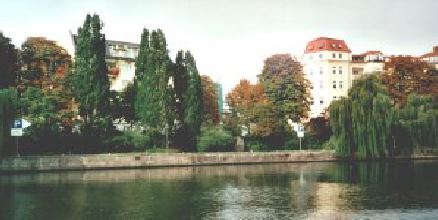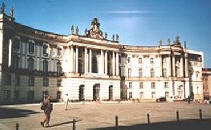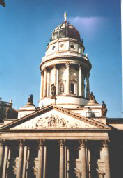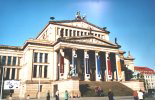




It was in 1978 that I first visited the wall dividing East and West Germany. Well, the wall that I saw was really a fence. It stretched as far as the eye could see in the North and South direction. Heavily fortified with mines and booby traps, guard towers every half a mile and cultivated areas stretching back a half a mile towards the east from the fence, made the erection a very formidable obstacle and the patrolling East German border guards appeared to eliminate all routes of escape. But in Berlin, the city was divided by a solid concrete block wall with a concrete coping on top. I never got to Berlin during this period and it was not until a fortieth wedding anniversary present that a visit to that Capital was possible in October 2001. By this time, of course, most of the wall in the central area of Berlin was removed and free access was possible between all parts of the city.
My wife and I set off from Edinburgh Airport for Berlin via Frankfurt for our four day sojourn in the city. We landed at Tegal airport and got a taxi to the five star Berlin Hilton Hotel. To our surprise, this was situated in the former East German area. It was situated immediately adjacent to Gendarmen-markt and a short distance from Friedrichstrasse, Unter den Linden, the Brandenburg Gate and the Reichstag as well as within walking distance of Checkpoint Charlie the famous crossing area between East and West Berlin. The Hotel, though in the former “East” Berlin, was of course very central indeed and the erection of this most modern and palatial accommodation was typical of what one found in this part of the city. There were many similar developments emanating from the former line of “the Wall” eastwards. But you only had to walk a few hundred metres towards the East to find the dereliction and neglect left by the former DDR. A typical example was the former “new” building of the former DDR Parliament. At the time of our visit, it was in the course of demolition because of the deterioration in the structure and also because asbestos had been used in the construction of the building. Dinner that evening was in a newly opened Bavarian Restaurant adjoining the Hotel.
The next day to our arrival in the city was a Friday, so as we normally do when visiting such areas, a coach tour of central Berlin was arranged by the hotel Concierge. With a tour guide speaking both German and English, the tour consisted of a three hour trip showing us the highlights of the capital.. It showed us the Kaiser-Wilhelm-Memorial Church, Europe-Centre, Bauhaus Museum, New National Gallery, Philharmonic Hall, Potsdam Square/Sony-Centre, Gendarmen-markt, Alexander Square, St-Nikolai-Vertel, City Hall of Berlin, TV-Tower, the Berlin Cathedral, Zeigaus, State Opera, Boulevard Unter den Linden, Brandenburg Gate, Reichstag, Haus der Kulturen (former Congress Hall), Tiergarten, Bellevue Palace, Seigessaulle. Charlotttenburg Palace, Olympic Stadium, Grunlewald Forest, Radio Tower, ICC, Kurfurstendamm. This was great value at 42 DM (£14) per person.
There was a lot of information to assimilate, but undaunted by all that, we then took a Taxi to join one of the many boat trips along the Spree and other Canals from Schlonbrucke. Again this was a three hour trip and though the commentary was only in German, we managed to follow the route using the map passing many of the sights we saw in the morning coach tour such as Charlettenburg Palace, Reichstag, Museum Island and Berlin Dom. However this time, the view was from the Spree/Canal and gave a different aspect, especially in the Eastern part of the city where we saw much of the Wall, miles of which still existed.
So that evening, with our minds crammed with information, we settled down in the Hotel and had dinner in the Hotel’s German Restaurant which was just wonderful.
The following day was Saturday, and with the sun shining brightly and the temperature in the mid 60 degrees F, we decided on a walking tour from the Hotel using the first class Dorling Kindersley Travel Guide book on Berlin.The Hotel, of course, is situated in Gendarmenmarkt. This is one of Berlin’s most beautiful squares, created at the end of the 17 Century as a market square for the newly established Friedrichstadt. It is named after the Regiment Gens d’Armes who had their stables here. In 1950 it was named Platz der Akademie; after reunification the square reverted to its original name. The three most important buildings on the square are:-
Franzosischer Dom: This is one of two churches standing at the opposite sides of the square and they appear identical but in fact differ considerably. The only common feature is the identical front towers. This French cathedral was built by the Huguenot community, who found refuge in protestant Berlin following from their expulsion from France after the revolution of the Edict of Nantes.
Deutscher Dom: This cathedral at the other end of the square from Franzosischer Dom and opposite the Hilton Hotel is an old German Protestant church. It was designed by Martin Grunberg and built in 1708 by Giovanni Simonetti. In 1785 it acquired a dome-covered tower identical to the French Cathedral. Burned down in 1945, the church was rebuilt in 1993.
Konzerthaus: Home of the Berlin Symphony Orchestra, this is a late neo classical jewel. This magnificent building recently known as the Schauspielhaus, is one of the greatest achievements of Berlin’s best known architect, Karl Friedrich Schinkel. It was built between 1818 and 1821. Following Bomb damage in World War II it was reconstructed as a concert hall with a different interior layout. The exterior was restored to its former glory.
Just a short distance from Gendarmen-markt is Unter Den Linden and Bebelplatz. Unter den Linden is one of the most famous streets in Berlin. It starts at Schlossplatz and runs down to Pariser Platz and the Brandenburg Gate. It was once the route to the royal hunting grounds that were later transformed into the Tiergaren. In the 17 centuary the street was planted with lime trees, to which the street ows its name. Although removed around 1658, they were replanted in four rows in 1820.
During the 18th centuary, Unter den Linden became the main street of the westward growing city. It was gradually filled with prestigious buildings which were restored after Warld War II. Following the reunification of Germany, Unter den Linden has acquired several cafes and restaurants, as well as many new smart shops. Within the last two years, sponsored by local shops hotels and offices a number of highly coloured bears have been erected over its whole length which adds much interest and colour for the tourist.
Situated off Unter den Linden are Humboldt Universitat, Staatsbibliothek, Reiterdenkmal Friedrichs des Grossen (a statue depicting Frederick the Great created between 1839 and 1851),The Altes Palais, Alte Bibliothek, Bebelplatz, St-Hedwigs Kathedrale, Staatsoper Unter den Linden (the State Opera House) and Crown Prince’s Palace. We spent most of the morning in this locality before moving on to Museum Island.
We spent the rest of Saturday afternoon on Museum Island and the surrounding area. On this island are the pretty Lustgarten and Berliner Dom (Berlin Cathedral). It is also where you will find some of the most important museums in the east of the city. These include the Bodemuseum, the Altes Museum, the Alte Nationalgallerie and the splendid Pergamonmuseum famous for its collection of antiquities and visited by crowds of art-lovers from around the world.
The Pergamonmuseum was built between 1912 and 1930. It houses one of the most famous collections of antiquities of Europe, and ows its name to the famous Pergamon Alter which takes pride of place in the main hall. the three independent collections - the Museum of Antiquities (Greek and Roman), the Museum of Near Eastern Antiquities and the Museum of Islamic Art - are the result of intensive archaeological excavations by German expeditions to the Near and Middle East at the end of the 19th and 20th century. What makes this museum particulary fascinating for the visitor is the first class audio CD ROM which is available to all on entering the building and which is carried over the shoulder during the visit with
The final part of the afternoon was spent shopping in Friedrichstrasse before returning to the Hotel to freshen up for another outing in the evening to one of the many Bistros in the vacinity for another wonderful meal.
Our next day was Sunday, and since the shops were closed, the morning was spent on a visit to Checkpoint Charlie which was the most well-known border crossing between East and West. There is a wonderful museum adjoing the crossing point which is well worth a visit to view the many exhibits of that era and to view the many photographs.
Our final trip was a coach tour to Potsdam. Here we saw the bridge which was used to exchange spies during the cold war and we also passed the former KGB headquarters. Postsdam is only now recovering from the neglect of the cold war era and the heavy bombing it received at the hands of the alies during April 1945 at the end of Warld War II.
Our final visit that afternoon was to the Park Sanssouci and a guided tour round the Schloss Sanssouci.



Alt Bibleoothek
Konzerthaus
Franzosischer
The River Spree as it is today
OR




